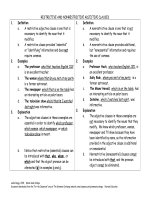More about adjective clauses
Bạn đang xem bản rút gọn của tài liệu. Xem và tải ngay bản đầy đủ của tài liệu tại đây (13.12 KB, 1 trang )
More about adjective clauses
We have already seen that an adjective clause is a subordinate clause that does the work of an adjective. It
qualifies a noun or pronoun in the main clause.
An adjective clause is introduced by a relative pronoun or a relative adverb.
Uneasy lies the head that wears the crown. (Here the adjective clause is introduced by the relative
pronoun that.)
The reason why she did it is obvious. (Here the adjective clause is introduced by the relative adverb why.)
The site where the accident occurred is nearby.
He is the boy who won the first prize.
Notes
The relative pronoun or relative adverb introducing an adjective clause is sometimes understood, and not
expressed.
Eat all that you can. OR Eat all you can.
I saw a man whom I knew. OR I saw a man I knew.
Where is the parcel that he sent to me? OR Where is the parcel he sent to me?
The reason why I have come is to ask for my money. OR The reason I have come is to ask for my
money.
A to-infinitive can often replace an adjective clause.
Compare:
Give me some water which I can drink.
Give me some water to drink.
He has no clothes which he can wear.
He has no clothes to wear.
I have some work which I must do.
I have some work to do.
Stay on top of your writing! Download our grammar guide from www.englishgrammar.org to stay up-to-date.
Powered by TCPDF (www.tcpdf.org)









